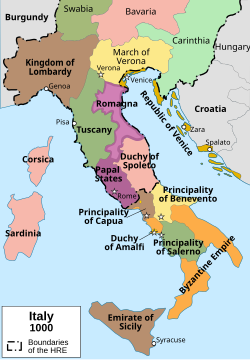Duchy of Spoleto
| Duchy of Spoleto | ||||||||||
|
Ducatus Spolitanorum (Latin) Ducato di Spoleto (Italian) |
||||||||||
| State of the Holy Roman Empire | ||||||||||
|
||||||||||
|
The Duchy of Spoleto shown within Italy, circa 1000
|
||||||||||
| Capital | Spoleto | |||||||||
| Government | Principality | |||||||||
| Historical era | Middle Ages | |||||||||
| • | Spoleto annexed by Lombard Kingdom |
570 | ||||||||
| • | Kingdom annexed by Charlemagne, granted to the Church |
776 |
||||||||
| • | Duchy resurrected as Frankish margraviate |
842 |
||||||||
| • | Berengar II retook Spoleto | ca 949 | ||||||||
| • | Investiture Controversy | 1075–1122 | ||||||||
| • |
Emperor Otto IV granted to Papal States |
1201 | ||||||||
| • | Duchy brought under direct Papal control |
1213 |
||||||||
|
||||||||||
The Duchy of Spoleto (Italian: Ducato di Spoleto, Latin: Dŭcā́tus Spōlḗtĭī) was a Lombard territory founded about 570 in central Italy by the Lombard dux Faroald.
The Lombards, a Germanic people, had invaded Italy in 568 AD and conquered much of it, establishing a Kingdom divided between several dukes dependent on the King, who had established his seat in Pavia in 572. In the following years they also conquered much of southern and central Italy, conquering the important hub of Spoleto, in what is now Umbria, in 570.
A decade of interregnum after the death of Alboin's successor (574), however, left the Lombard dukes (especially the southern ones) well settled in their new territories and quite independent of the Lombard kings at Pavia. By 575 or 576 Faroald had seized Nursia and Spoleto, establishing his duchy and sponsoring an Arian bishop. Within Spoleto, the Roman capitolium dedicated to Jupiter, Juno and Minerva had already been occupied by the bishop's cathedral (the see was founded in the 4th century) which incorporated the pagan structure (now the church of San Ansano). The Lombard dukes restored the fortifications of the high rocca, whose walls had been dismantled by Totila during the Gothic War.
The dukes of Spoleto waged intermittent war with the Byzantine Exarchate of Ravenna, and Spoleto's territories fluctuated with the fortunes of the times over much of Umbria, Lazio, the Marche and the Abruzzi. Never as important as the Duchy of Benevento, Spoleto has a fairly obscure spot in Lombard history, nevertheless. Its second Duke Ariulf made frequent expeditions against the Byzantines (579–592 against Ravenna; 592 against Rome). Ariulf was succeeded by Theudelapius, son of Faroald, whom the Catholic Encyclopedia credits with the first building of the present cathedral. Then came Atto (653), Thrasimund I (663), and Faroald II (703), who ruled conjointly with his brother Wachilap. Faroald II captured Classis, the port of Ravenna, according to Paul the Deacon's History of the Lombards: "In that time too Faroald, the first dux of the Spoletans, invading Classis with an army of Lombards, left the wealthy city despoiled and bare of all its riches." He was then obliged by the Liutprand, King of the Lombards to restore it, a measure of the loose central control of Lombard rule that Liutprand was occupied in tightening, at least as Paul interpreted events for his Frankish patrons. At Spoleto Faroald was deposed by his son Transemund II (724), who also rebelled against Liutprand and formed an alliance with Pope Gregory III, who sheltered him in Rome in 738. Ilderic, who had replaced him as duke, was slain by Transemund in 740, but in 742 Transemund was forcibly retired to a monastery by Liutprand, who conferred the duchy that he had rewon by force of arms upon Agiprand (742). By the time of Liutprand's death (744), Spoleto was more securely in central control from Pavia, and Theodicus succeeded peaceably. Three 8th century dukes were Kings of the Lombards, a sign that in that period Spoleto was linked more closely to the kingdom than was Benevento.
...
Wikipedia

